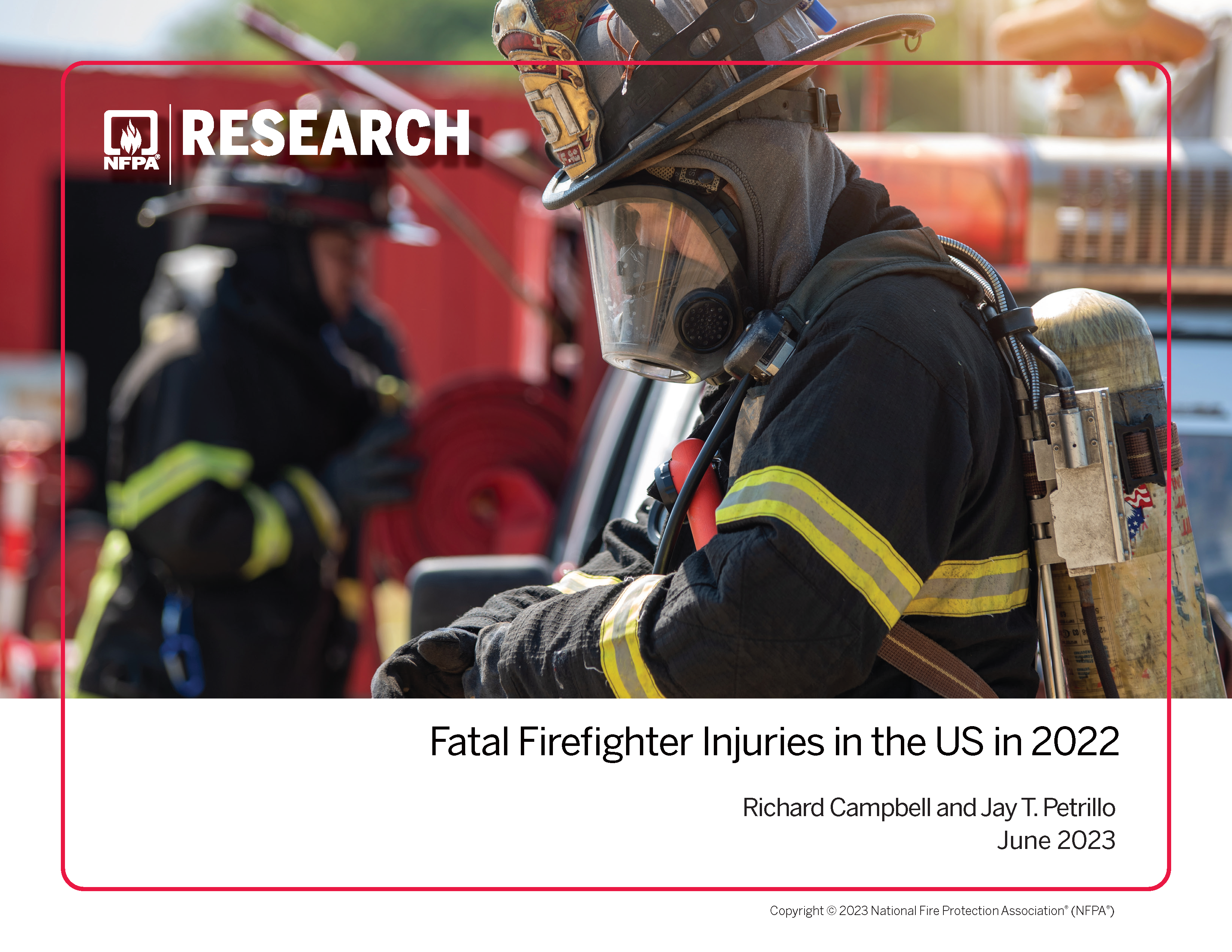New NFPA Report Available on Fatal Firefighter Injuries in the U.S. in 2022
June 27, 2023
 The National Fire Protection Association® (NFPA®) released a new report on Fatal Firefighter Injuries in the U.S. in 2022, which showed a total of 96 on-duty U.S. firefighter fatalities last year. Of these deaths, 51 were volunteer firefighters, 38 were career firefighters, six were contractors for federal or state land management agencies, and one was a full-time federal land management employee.
The National Fire Protection Association® (NFPA®) released a new report on Fatal Firefighter Injuries in the U.S. in 2022, which showed a total of 96 on-duty U.S. firefighter fatalities last year. Of these deaths, 51 were volunteer firefighters, 38 were career firefighters, six were contractors for federal or state land management agencies, and one was a full-time federal land management employee.
The number of injury and cardiac-related fatalities in 2022 is higher than past years, largely due to the inclusion of deaths occurring within 24 hours of duty, which were previously not counted in the report unless there was a specific physical complaint while on duty. The report now includes fatal injuries and cardiac deaths that occurred within 24 hours of duty, irrespective of manifested or reported symptoms.
“Sudden cardiac deaths or cardiac conditions regularly account for the largest share of on-duty firefighter deaths,” said Richard Campbell, author of the report and a senior research analyst at NFPA. “By adjusting the reporting period by 24 hours, we were able to more fully capture cardiac failure among firefighters, allowing us to more accurately identify the serious health risks firefighters face on the job.”
However, Campbell notes, an unknown number of deaths due to unspecified medical causes in 2022 were likely cardiac related, so the reported number of cardiac deaths likely continues to understate the true total.
The report categorizes the type of duty that firefighters were engaged in when the deaths occurred, including deaths that occurred:
- on the fireground;
- at a non-fire emergency;
- responding to or returning from emergency calls; and
- during training
Trauma injuries accounted for 33 firefighter deaths, including 20 internal trauma deaths, six deaths by crushing, five deaths due to unspecified traumatic injuries, and two deaths due to gunshot injuries or projectile wounds.
In addition, six multiple fatality incidents occurred in 2022, tying for the highest number of multiple fatality incidents since 2009. Four of the incidents involved vehicles, each resulting in two fatalities. The two remaining incidents involved structure fires, one in which three firefighters were killed in a building collapse and the other in which two firefighters died after sending a mayday from the second floor of a house.
Just over one-fifth of firefighter deaths (21) occurred while responding to or returning from emergencies. The report also showed that overexertion and stress accounted for just over one-half of the deaths in 2022. Of the 49 deaths in this category:
- 34 were sudden cardiac incidents and one was due to cardiac symptoms;
- 11 deaths included an unspecified medical cause;
- one was due to a stroke or aneurysm; and
- two deaths were the result of drug overdoses.
According to the report, excluding the 340 firefighter deaths that occurred on 9/11, the highest fatal injury total was 174 firefighter deaths in 1978 and the lowest was 48 deaths in 2019. This overall downward trend is an encouraging indication that firefighter injury prevention and health and wellness efforts through the years are being met with success. At the same time, the data shows that work as a firefighter includes significant physical demands, taking place in environments that involve a range of hazardous conditions and presenting risks not only at fire scenes, but during training activities, non-fire emergencies, and transport to and from emergency scenes.
“While significant strides have been made over time to better protect firefighters on the job, firefighters continue to take on more roles and responsibilities, placing significant physical and mental stresses on them that can have fatal consequences,” said Campbell. “Ongoing efforts to adequately address these issues will be needed in order to see meaningful reductions.”
This Firefighter Fatal Injuries study is made possible by the cooperation and assistance of the United States fire service, CDC’s National Institute for Occupational Safety and Health, the United States Fire Administration, the Forest Service of the U.S. Department of Agriculture, and the Bureau of Indian Affairs and the Bureau of Land Management of the U.S. Department of the Interior.
About the National Fire Protection Association (NFPA)
Founded in 1896, NFPA is a global, nonprofit organization devoted to eliminating death, injury, property and economic loss due to fire, electrical and related hazards. The association delivers information and knowledge through more than 300 consensus codes and standards, research, training, education, outreach and advocacy; and by partnering with others who share an interest in furthering the NFPA mission. For more information, visit www.nfpa.org. All NFPA codes and standards can be viewed online for free at www.nfpa.org/freeaccess.



